Acrobatic, inquisitive and colourful, Blue Tits are a garden favourite. They are one of the easiest garden birds to attract to nest with a suitable nest box, and they are a frequent peanut feeder once the dominant sparrows are gone!
Scientific name: Cyanistes caeruleus
Is there anything you’d like to know about Blue Tits that isn’t covered here? Please ask us in the comments below.
A blue-tit darts with a flash of wings, to feed
Where the coconut hangs on the pear tree over the well;
He digs at the meat like a tiny pickaxe tapping
With his needle-sharp beak as he clings to the swinging shell.Then he runs up the trunk, sure-footed and sleek like a mouse,
Summer-Like by George Orwell
And perches to sun himself; all his body and brain
Exult in the sudden sunlight, gladly believing
That the cold is over and summer is here again
Where do Blue Tits live?
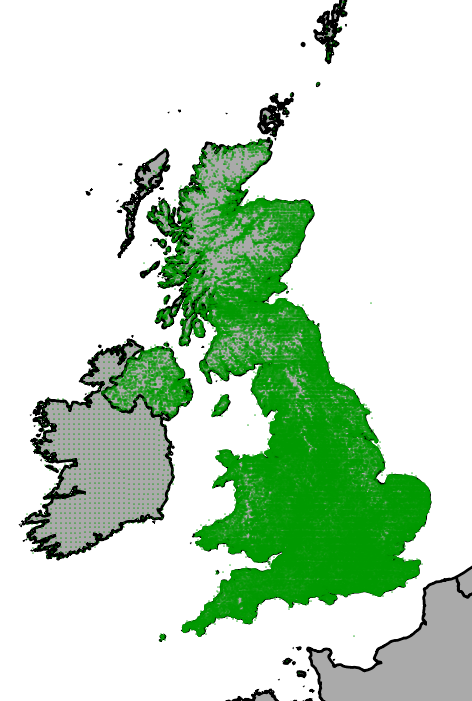
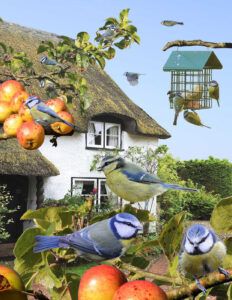
Blue Tits are common throughout woodlands, parks and gardens across the UK, just absent from some Scottish highlands and islands. They are very much a European bird, present almost everywhere across the continent but otherwise barely extending to parts of Asia.
They are resident birds and, although they roam in winter, it is rare for them to travel more than a few miles. A few more nomadic birds from Northern Europe do visit southeast Britain in the winter.
What food do Blue Tits eat?
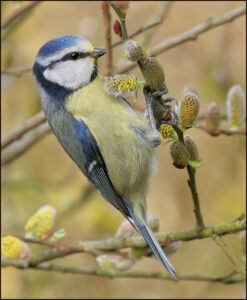
Blue Tits are very active feeders, naturally flitting among small branches of woodland trees looking for insects and spiders. When nesting they feed mostly caterpillars to their young.
They are one of the most welcome and frequent visitors to garden bird feeders, especially for peanuts but also seeds and fat balls.
Where do Blue Tits nest?
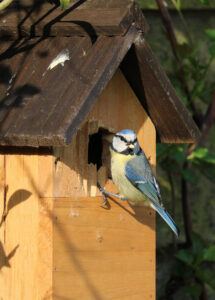
Cavities with small holes in tree trunks are the main nesting site, but the adaptable Blue Tit is one of the most regular users of nest boxes. It is also known to use holes in walls, pipes, letter boxes, street lamps and even remarkably a drain on the ground!
The female builds the nest from moss and leaves, lined with soft materials such as hair, down feathers and spiders’ webs. Clutches are large, typically 8 – 12 eggs, and the resulting chicks mean hard work for the parents, trying to find as many as 1,000 caterpillars per day to feed them!
What do Blue Tits look like?
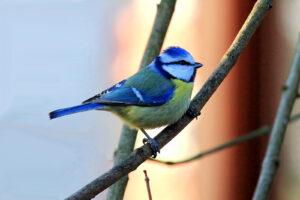
Blue Tits are a colourful mix of blue, yellow and green, with white cheeks and a thin black eyestripe.
Males and females are virtually identical, although males are a slightly brighter blue on the head, wing and tail. They get brighter with age, so it is tough to be sure if you are looking at a young male or older female!
Incidentally, birds can see ultraviolet light and the Blue Tit’s blue crown is highly reflective under ultraviolet. Studies have shown that males tend to choose brighter females, and this seems to be a sensible decision because they fledge more chicks than duller mothers!
In the spring, males perch and sing prominently, and they may do a short display flight, gliding down with their wings held out.
What do baby Blue Tits look like?
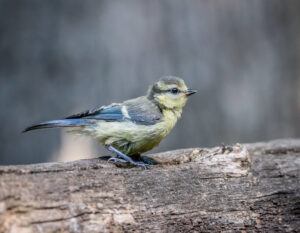
Young Blue Tits can easily be told apart, with most of the blue being more subdued and greenish, and the cheeks yellow.
What do Blue Tits sound like?
The song is typically a pleasant high-pitched ‘tsee-tsee-tsee’ followed by a trill.
Blue Tits have a variety of calls, including ‘ti-ti-ti chur’ contact calls and a scolding chatter alarm call.
How to attract Blue Tits?
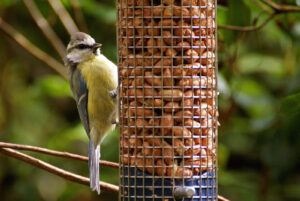
Peanuts and fat are the best foods for Blue Tits, especially during the winter. Place whole peanuts in a mesh container, and ideally hang more than one in different areas so that the shyer tits don’t get outcompeted by aggressive House Sparrows!
A nest box with a small round entrance hole will encourage Blue Tits to nest in your garden, with the small hole preventing larger birds from using it.
More facts about Blue Tits
Roving tit flocks
In late autumn and winter, family flocks of Blue Tits often join up with other small birds as they search for food, forming ‘roving’ flocks. These may well pass through your garden, and hopefully dally a while if there is good feeding. Other tit species including Long-tailed, as well as Chaffinches, Goldcrests and Treecreepers, may be in the flock of 10 – 20 birds or more, making soft contact calls to keep in touch. A ‘roving tit flock’ survey by the Young Ornithologists’ Club recorded over 40 different species in such flocks.
Because of this behaviour of ‘passing through’ the area, there will be many more individuals visiting your garden than you ever see at one time.
Blue Tits and milk bottles
It was about 100 years ago when the ingenuity of Blue Tits raiding the cream on top of doorstep milk bottles was first recorded. By the 1950s they were recorded across the entire UK piercing the aluminium foils and successfully getting to the energy-rich cream, gaining a ‘viral’ fascination amongst the public. They were even known to identify which colour bottle tops indicated skimmed milk so they could avoid those, and to follow milk floats awaiting the delivery! A 1949 British Birds paper gives a fascinating account of the spread of this behaviour. Sadly the lack of doorstep deliveries these days means the behaviour is now relegated to folklore.
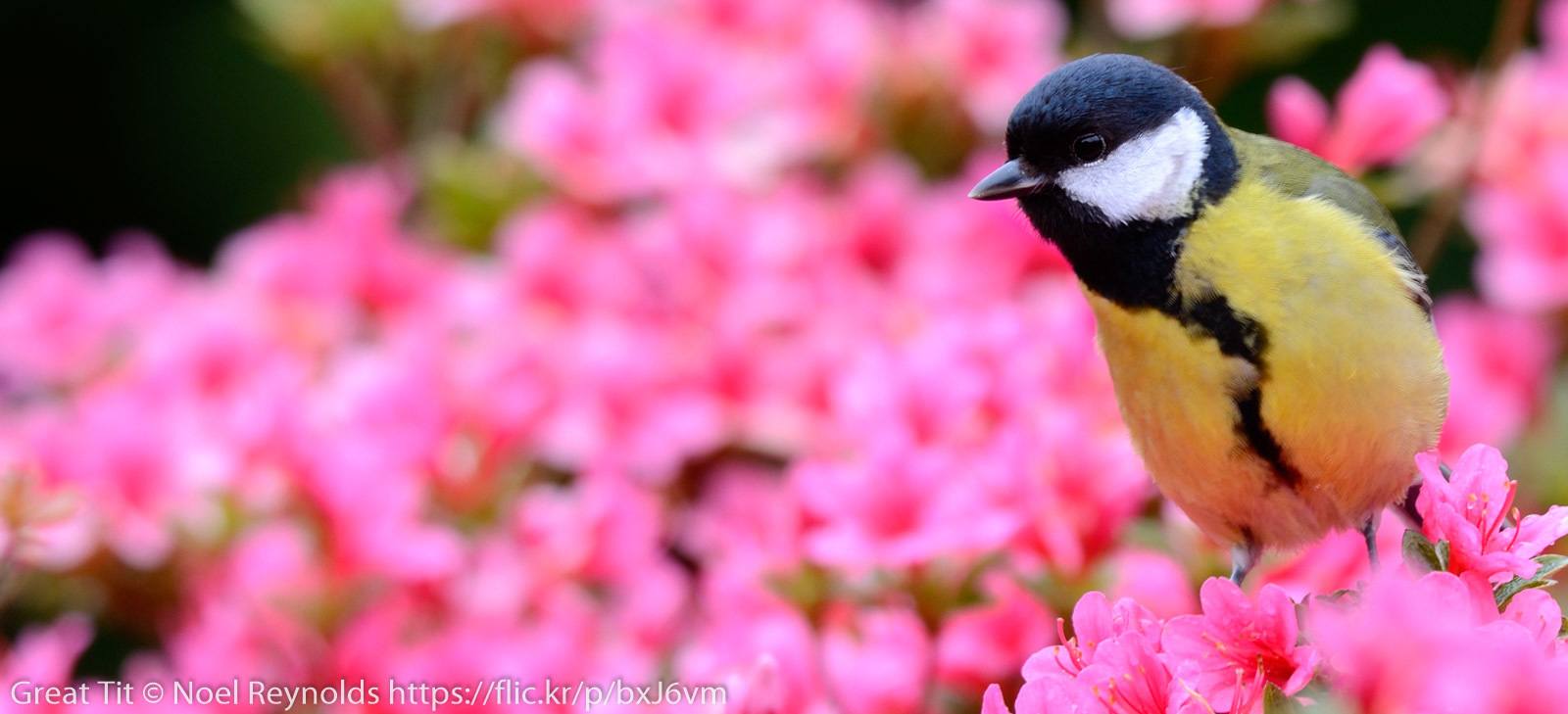
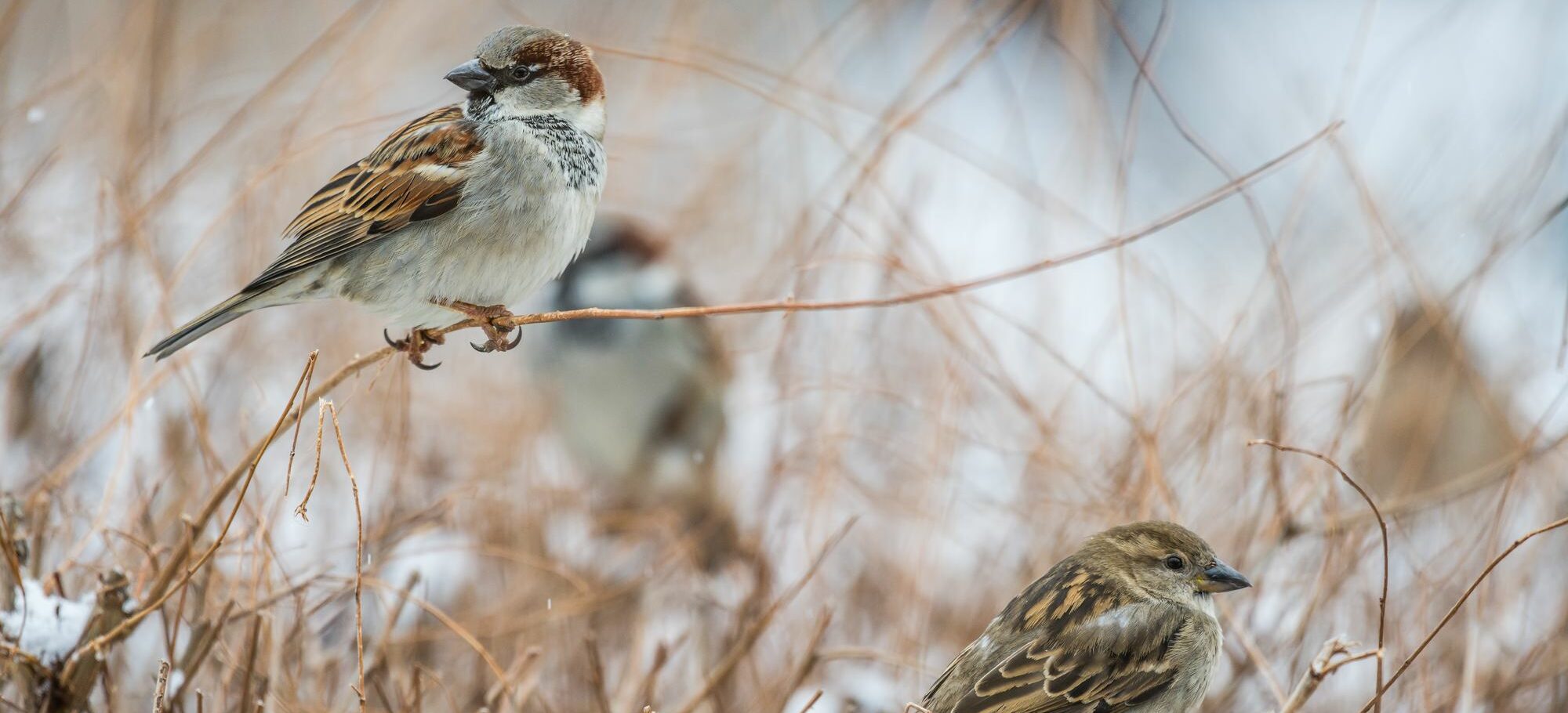
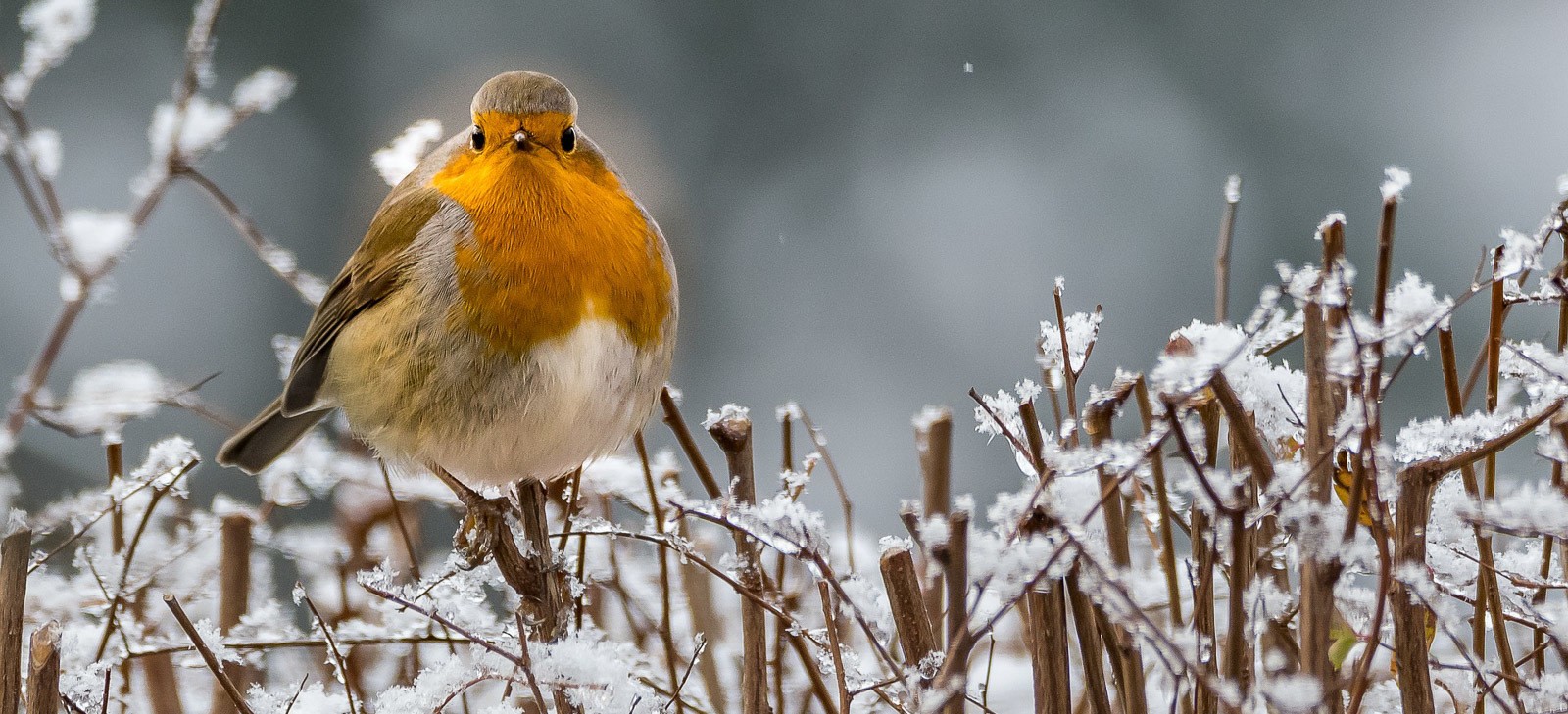
Hi,
Your content is very well-written and well-organized with all the pictures and audios places in a clean manner. I’m so excited to have learned so many exciting things about Blue Tits and I really enjoyed the sound of bird. I’d love to visit your site again to learn more about other birds as I’m also quite a fan of animals and birds. 🙂
Thanks very much. We’ll be covering more of the most common garden birds over the next few days.
We moved house in March just before the lockdown & put up a bird box on our garden fence. It wasn’t long before a pair of blue titis took interest in it & we watched them taking nesting materials into it. A few days ago we noticed no activity at all & today we looked into the box & found a beautifully made nest.
No eggs at all. What could have happened? And should we clear the nest out of the box? Very sad.
Same experience this morning although we haven’t looked in the box yet. We’re puzzled!
We live in south London and see tits every day at our bed feeder in the warmer months. I am very worried that all I see at present are robins and pigeons – no tits or finches. I have only recently begun washing and disinfecting bird feeder every 8-10 days. I saw one bird that looked unwell just sitting on the bird feeder. Do you think they have caught one of the diseases that are spread at feeders? Hilary
I think that’s unlikely: you’re cleaning them frequently enough. One problem that I find in my garden is that too many other people nearby are feeding the birds, and have better gardens! At this time of year you might suffer from the same!
We had exactly the same thing happen to us and joked that we think they’re using it as a weekend retreat! But please be patient as ours have returned several times and now we’re sure that there are little chicks in there but I haven’t wanted to look in the box. We have been watching the tits going in and out all day for 3 days now. I feel so privileged that they’ve chosen our garden especially as I have 2 Great Danes
In our 1st batch of nesting tits (in end March/April) at 3am (in the middle of the night) I noticed a mouse popping it’s head out of the nesting hole ! (eaten the eggs?) The tits never returned. BUT great news (end of May same year) another family have arrived, and are laboriously feeding the chicks in the same nesting box. (the box is outside my window so I can keep an eye on them).
I’ve tried various seeds and feeders to attract blue tits and finches to my feeders but without success. I have a big tree outside my flat and there are a number of squirrels around plus pigeons and jackdaws but no small birds. Can you advise what else I can do to attract small birds to my feeders.
It may just be that other nearby areas are more suitable for small birds. At this time of year there is probably plenty of natural food around, and they have less need to come to some gardens where there are other more dominant birds. If there are native plants with seasonal fruits and berries that will help wildlife in general. You may get more luck in the winter when birds are more dependent on food we put out.
Over two years ago our son set up a nesting box complete with camera so that we could watch any birds that came to it. Nothing happened until last November when a blue tit began making it his home. He would arrive as it was getting dark, sleep there all night then wake up as it was getting light and fly out until evening. Every day he had the same routine until on 5th February he left and hasn’t come back. Would he have gone to look for a mate?
Birds often use nestboxes for roosting in, especially in the winter, which is what your Blue Tit would have been doing. It is possible that it would be pairing up soon, but whether it returns to nest in the same spot I’m not sure. I hope it does though!
Great information! I’m just now trying to create an oasis for birds and bees on my patio. They appreciate the environment and I appreciate the company. Thanks for including a “how to attract” section. I need all the help I can get!
I would love to know if anyone else has Blue Tits pecking at their windows..I have had this since last summer until late Autumn, and just about 3 weeks ago it started again! One at first, then it brought it’s mate along, they have even been pecking at the downstairs window when I have been there..they wake me up better than my alarm clock, bless ’em!
Pecking at windows is usually territorial, so happens in the breeding season mostly with birds ‘attacking’ the suspected intruder that they see in their reflection. They can breed in February, so it sounds like the breeding urge has kicked in again! Read a bit more about this at https://ww2.rspb.org.uk/birds-and-wildlife/bird-and-wildlife-guides/ask-an-expert/previous/window_tit.aspx
I have had 3 blue tits sitting on my window sill twice in the past 2 weeks. They wake me up. I wonder what they signify.
do tits store peanuts
Coal Tits are well-known for storing peanuts, e.g. see https://www.bto.org/our-science/projects/gbw/gardens-wildlife/garden-birds/behaviour/caching. As far as I am aware though, neither Great or Blue Tits are known for doing this.
It’s January and two blue tits have been using a blue tit box to shelter in. Nothing strange in this, but I have watched them taking whole nuts and seeds and dropping them into the box, I have never seen this before. They are obviously storing food for later.
how much do individual blue tits eat per day? We fill our bird feeder daily with sun flower seeds. I have weighted this at 364grams and weighted 100 seeds at 5grams this works out at approx. 7300 seeds per day. I assume half gets dropped on the floor and eaten by other birds mice etc.
this seems to mean that the blue birds are eating around 4000 seeds a day is this possible.
Do they fly off and store seeds? or am I feeding 100 blue tits 40 seeds each every day.
in addition to the sunflower seeds they are also eating 3 fat balls per day.
I have read that Blue Tits apparently need more than 150% of their body weight in food each day! So at about 12g each, that means at least 18g of food which very roughly would mean 400 of your seeds each (if that was all they ate!
To add a couple more interesting facts, as many as 200 birds in a day have been recorded visiting a single feeder and, when they have chicks to feed, Blue Tits might need to provide 100 caterpillars to each chick every day, meaning they’d have to find 1000 caterpillars daily for a brood of 10!
Hi
I have a bird box in my garden that Blue Tits seam to be making a nest the question I would like to ask my Motorhome and Wife’s car are parked on our drive for some reason One Blue Tit is back and forth to both vehicles landing on the mirrors or the darken windows and keeps pecking and dirtying if I cover up the windows and mirrors he goes and finds another vehicle to do the same is this natural
Hi Gareth
Quite a few birds are known to “attack” their reflections, especially during the breeding season: https://www.bto.org/our-science/projects/gbw/gardens-wildlife/garden-birds/behaviour/windows. Going to other mirrors when you cover yours up is surprisingly persistent: it almost seems to be seeking out intruders! I expect that it will not be so bothered later in the breeding season, and maybe earlier if it realises the intruders don’t seem to be causing a big problem!
I have built a bird box and the inlet hole is about an inch in diameter. Birds ( blue tits ) have moved in and at the moment seem to be trying to enlarge the hole. Can they do this with their tiny beaks ?
Hi Roger
The whole size should be perfect for Blue Tits (but a little small for Great Tit) but clearly yours don’t think so! In the wild they almost always adjust holes which obviously aren’t all the ideal size to begin with, and it’s quite common for them to do so with nestboxes. It is also thought that this might be a form of territorial display by the male, and females checking the softness of the wood – many times they seem to be enlarging holes that are quite large enough already. See this nice video of a Blue Tit enlarging a nest box hole.
We have just had the most wonderful 3 or 4 weeks watching the blue tits feeding whatever was in the nest box. I have no idea how many chicks were in there but the parents were non stop in and out. Then 3 days ago nothing. It was so quiet, no birds at all. Fledged. But where do they go. What and where are they at night say ? Will the parent birds come back for another brood. Do I leave the box well alone ?
That’s super! They do seem to disappear very quickly when fledged! (I’ve missed this moment with Blue Tits in my own garden before.) It’s not surprising really though, as this is when they are most vulnerable so it is in their interests not to hang around for long. They presumably don’t move far and so would be in the neighbourhood, at least for a while. They won’t use the nest for roosting though.
Blue Tits may have a second brood, although usually this is only if the first has failed. It’s always possible another pair might occupy the box, so do leave it alone. I think about October is when it can be cleaned out, although this is another topic of debate since many people prefer to just leave them naturally.
We have had blue tit nests on camera for the last 4/5 years. This year the mother bird constantly chirrups to her babies and occasionally her partner. We have never heard this before.
I’m sorry this isn’t a reply but I don’t understand this behaviour. I brought a nesting box with when I moved 100 miles south: hung it: never used until this spring. The fledglings began leaving the box 6 May and I saw the 11th leave 10 May.
On 13 May two adult birds were interested in the box. I saw them flying in and out and by 15 May it was very obvious that they were feeding young and not, as I had supposed, tidying the nest box and the female laying eggs. Can you please explain this
Hi Barbara
That’s very interesting. I would have thought that there was just a delay in fledging for some birds: if they were feeding young on 15th then these must have been part of the same brood that you saw leaving the nest. However, to have had 11 young birds fledge and then still be feeding more is remarkable! What has happened since 15th?
I have observed a very strange behaviour with my blue tits this year.
On the few days up to and including the 21st May both adults were frantically visiting the nest every 25/40 seconds. I presumed they were feeding their young. Strangely, I never heard the young ones making any noise as I always did in previous years.
On the 22nd morning there was no activity toward the box and I presumed that the youngs had fled. Later in the afternoon, one of the adults appeared making multiple visits to the box but not actually going in, just hopping from the hedge (2ft away) to the outside of the box, making chirping noises. I assume it was coaxing the last fledging out… this behaviour lasted about 2 hours. The adult bird then disappeared and I thought that that was the last visit to the nest. I cautiously looked into the box which at first appeared empty. On more careful inspection, I found 2 possibly three new tiny babies, just hatched.
From the 22nd May evening and up to this morning, it appears that only one of the adult is returning to the box at lengthy intervals. is this a second brood or batch? what will happen to these little ones?
How do I prevent pigeons from getting to my bird table and thus prevent the smaller bird from feeding? They even prevent the smaller bird getting to the nut and fatball feeders.
Hi Roger , I have had nesting Blue Tits for a great number of years and can honestly say never had any sign of casualties . I have been using a camera nestbox for about 10 years and also with great success , having broods of 8-9 ‘s . The bird this year had 10 , and I was so excited . All seemed well , then on the 10th day after hatching, I lost 5 . The female had covered them up . The remaining 5 didn’t seem good and refused food from both parents . I phoned the SSPCA and they came and took the birds , they said they were a bit dehydrated but doing fine now .Have you come across this before ?
blue tits like to eat bees
This has been recorded before I believe, but is probably unusual. It would be great if you could provide some details of your observations.
I’ve just cleared out the bird box, after its use by a family of blue tits. Sadly, there is one dead chick but I can’t find any trace of the chicks eggs. Do the parents eat them for the calcium?
Yes they do eat the shells: see https://youtu.be/FgjjcCCk4UU for an example. I’m not sure how normal this is for Blue Tits: many species will remove the shells and discard them away from the nest.
we have a bird box with fitted camera and watched several broods hatch and fledge but this for the first time we saw the last 3 birds leaving the nest during the day the surprise was that evening three birds came back for the night also one was back for the next two or three nights is this usual as we have not seen it befor
First time blue tits have nested in our box and just when I had decided to try out a bird box camera but never got to install it after finding nest and sitting bird. Missed opportunity right there, nevertheless feeding seems to be ongoing so am going set up my Bushnell to see if I can at least get the fledging aspect covered 🙂
I have lived in Stockport for many year’s and not seen any of the blue tits here sadly. Since April have had a hanging bird feeder from the tree in my back garden with sunflower hearts and seeds in during this time I’ve only seen blackbirds, robins, sparrows, goldfinch and song thrush. I’m beginning to think that my town is just not rural enough for the blue tits 🤔 😔 if anyone sees this comment lives in Stockport has blue tits visit their garden please advise me what else I can do to encourage them.
Hi Sabrina
Not that I’m familiar with Stockport – I live in Bangalore, India! – but one obvious things to try would be a feeder with peanuts https://gardenbirds.net/feeding-birds-peanuts/ which are much preferred by Blue and Great Tits compared to seeds. If there is a city park not too far from you then I’m sure there must be Blue Tits around, so with luck you’ll get some.
Mind you, Song Thrush is more unusual and declining so you are lucky there! https://www.bto.org/our-science/projects/gbw/gardens-wildlife/garden-birds/a-z-garden-birds/song-thrush
Hiya,
I live in Stockport and have blue tits daily/hourly visiting my window table and hanging feeder. I use a mixture of seeds and suet balls, the birds seem to relish the suet! Yet to see a goldfinch in my garden but live in hope 😀
……or hear/see a song thrush. Also have frequent visits from great tits
Hi, thanks for the post. I have lots of Blur Tits coming for food on my balcony at any time starting from 6 am, however, suddenly they stop coming this week even though I filled the Container Feeder with new Blue Tits Food… Why? Nik 11 June 2020.
What colour are blue tits eggs please?
They are off-white and lightly speckled brown. The Woodland Trust have a very good article about identifying eggs shells.
How would their future be and could you explain more about their life cycle. Very good written 🙂
We have just bought a very deep nesting box with camera. The box has two translucent ‘windows’ in the sides so that there is loads of light in the box. I am concerned that this is not a natural sort of place for blue or great tits to nest and wondering if I should blank out the ‘windows’. Any thoughts
That’s a very good question. It’s now quite common for nestboxes to have perspex windows to let sufficient light in for better photography, including some sold by reputable sources, but clearly this isn’t as natural as a regular nest site. I suppose if the birds still choose to nest in the box then they don’t see it as a problem, but it would be interesting to know if this does affect nesting success. I’m not aware of any studies done regarding this, but it would be a very worthwhile project. I think you would be fine to just try it as it is.
we have a blue tit who comes and uses a pine needle in his beak to throw seeds on the floor to get to meal worms i have never seen this before could he be bird brain of britian
Hi Cheryll
This is very interesting! I’ve heard anecdotally of Blue Tits using tools, e.g. a twig or pine needle to extract larvae out of holes, but couldn’t find anything published about this. If you ever get a chance to get a photo or video that would be amazing!
I live in an upstairs flat with no garden of my own, or balcony and unfortunately my windows open from bottom outwards but have been in lockdown so been so aware of the blue tits around a tree near to my flat. I would like to encourage them, thought of Just scattering seeds on the window sill outside.. is that an idea, a silly or dangerous idea ( for them not me!) and if so, what seeds? Thank you for the website, now I recognise the tunes they make as opposed to the noise of the pigeons and gulls!
Hi Cherry
Scattering seeds on the window sill may well work, for Blue Tits or other nearby birds. Black sunflower seeds are often good, but trying a mix might be better. You could also consider a window feeder like these: https://gardenbirds.net/recommends/cj-wildlife-window-feeders/. Although be careful fixing them if the window only opens at the bottom!
We have two bird boxes with cameras in. Throughout the winter each box has had a blue tit at night sleeping in it, and we hoped they would eventually build nests with a partner and have babies. However during spring they stopped coming, the boxes are now empty. Why is this please?
I don’t know for sure, but I would imagine it is more common for birds to nest in different sites to those that they use for winter roosting. They do tend to explore several nest sites before choosing one, and I guess in this case preferred a different site nearby: maybe a box in a neighbour’s garden!
Having said that, whilst I was researching I found one study describing Blue Tits that did indeed nest in the boxes they roosted in. It is a fascinating study of Blue Tit behaviour and pair formation, published in British Birds magazine. Even more remarkable when you consider that these observations were from 1938 and 1939! It suggests that the two Blue Tits you had roosting in separate boxes are quite likely to have been a pair, using separate bedrooms!
I am having building work done. The flat roof is being fibreglassed. I am worried that the blue tits are using loose fibres to build their nest. Is this dangerous for them?
Ideally they shouldn’t use synthetic fibres, but try telling them that if they are available! I’m not aware of birds actually having problems with the fibres, although they can be major irritants for humans of course. It’s probably best to try not to leave any easily accessible. You could also try leaving out an easier supply of natural fibres, leaves, small twigs etc. in a hanging basket or bush.
Hi everyone, I’m wondering if the billowing smoke from my neighbours garden fires have scared of the nesting blue tits nearby. They were in and out of the box every day for the last couple of weeks, building a nest I presume, followed by the hen laying. I know the hen lays only one egg a day before she broods them but for the last 3 days my neighbours have been clearing their garden, burning wood constantly and I haven’t seen the blue tits since they started doing this. The nest box is in close proximately, only a couple of metres away from the billowing smoke.
Does anyone know whether this has caused the birds to abandon the nestbox?
Hi Sue
Unfortunately that seems quite likely. Other than asking your neighbours if they can hold off for a while, which might be too late now if you haven’t seen the birds for a few days, I’m not sure there is much that you can do. Hopefully they’ll start again with another nest nearby, although if the hen has laid already that’s unlikely: Blue Tits do only rear one brood per year, and the female will have used up a lot of energy in nest-building.
Thank you for your insight. I enjoyed watching the blue tits from my kitchen window, it’s such a shame they have left. What really upsets me is my neighbours knew the birds were nesting and how delighted I was. It’s a sad case of of total lack of consideration and thought from my neighbours who prioritise laying a new lawn before the welfare of nature.
I really am sad about this, a selfish act that has not only resulted in the loss of wildlife but also affected my mental health.
Not much comfort to you personally and your birds, but Blue Tit is at least doing well overall in the UK: https://app.bto.org/birdtrends/species.jsp?year=2020&s=bluti. I hope you have some other birds in and around your garden to provide you some enjoyment. Take care.
We have a pair of blue tits investigating our bird box over the past week or so but have not begun to build a nest. Do they scout several habitats before choosing?
Yes, they are known to. Hope they choose your box!
We have a blue tit nesting in our box. She started building on 21st March and laid 5 eggs over a couple of days starting on 20th April. It looks as though 4 eggs hatched on 9th May. Now (14th May) there appears to be only 2 beaks opening for feeding and one unhatched egg. So, do the birds get rid of unhatched eggs and if, as it appears, 2 have died, do they remove the bodies?
It varies on the species: some birds do get rid of unhatched eggs, but it is quite common to find unhatched eggs in nest boxes if you clean them out in the autumn, so Blue Tits definitely don’t always remove them. Predation is a possibility, although not much could get inside a nestbox and remove eggs without leaving a trace: weasels are known to, but not regular garden visitors of course.
Similarly with dead chicks, both Blue and Great Tits are known to remove them but they don’t always. Springwatch filmed a Great Tit removing a chick a few years ago.
Do Blue tits just leave the babies when they are ready to fledge? We have some in a nest box making a lot of noise but no sign of the parents anymore. Is this normal if not is there anything we can do?
They will try to encourage the chicks to come out of the box when they are ready, so often call from outside. Hopefully this will have happened with yours by now
We have a small bird box in which a family of Blue Tits have been living and breeding for almost twelve weeks. When I prepared the box initially I sealed it and made it as comfortable as I thought a bird might like. We Don’t go near them but watch from afar. The Tits seem to be a little more used to us and don’t scare off when we are around. I mainly leave out flake meal on a bird stand for when they want to top up what they already collect. I know they have been breeding very successfully. it seemed to me that they may have had at least a second clutch of young. At what stage will they decide to leave?.
It’s actually very unusual for Blue Tits to have a second clutch. I think they have such large clutches, and put so much energy into raising this one successfully, that they cannot manage a second. They will fledge when they are ready, which is typically about 18-21 days from hatching. Once fledged you might see the young on the ground in the garden, but in my experience they seem to then disappear quite quickly. Of course, predation is a major risk in these first few hours and days. I hope yours were successful
I have a bird box in my back garden in which blue tits have been returning to the last few years, I think they fledged their chicks a day ago , I’d love to know where these lovely birds then go to for the rest of the year?
After breeding juveniles will venture to find new territories (“post-breeding dispersal”) but Blue Tits are known not to go far from where they hatched. They may have to travel further in cold weather in winter to find food, including sometimes to the continent. The BTO have a summary of Blue Tits found in Britain and abroad.
Do all bluetit fledglings fledge on the same day? We saw 2 fly the nest today and another has so far refused to leave. The parents kept returning and tried to cox them out but to no avail. They did take in food but by the evening appeared to go into the nest box less and less. Will the youngster be ok?
Normally they do, but I have heard of them taking 2 or 3 days occasionally. Maybe the stubborn one will go a day later. If it is weaker the parents may unfortunately give up on it: Blue Tits lay such large broods knowing that many won’t survive, and will concentrate on the ones that have already fledged and need feeding.
Blue tits feeding young in the nest visiting neighbours fat balls containing black sunflower seeds. Is this ok for the young to eat.
Sunflower seeds are an excellent food to give for Blue Tits and other birds. Usually parents are quite good at feeding their young the right food, e.g. insect grubs and caterpillars, whilst maybe eating provided food themselves. So I wouldn’t worry about it, and it is usually recommended to feed through the summer as your neighbours are doing.
We had a Flock of what I think were Blue Tit’s flying across our Garden late Morning today there were so many of them, I have never seen this before usually a few fly backwards and forwards across the Garden. It was such a lovely sight to see so many must of been about 40 or more. This was in Berkshire England.
We moved to an apartment and was worried we would never get birds. We hung up a basked and found 10 blue tits one day lining up. So we bought a proper feeder and have been feeding them all summer. Now it is October, I have not seen one for days. The food is going because the starlings also feed but not the lovely blue tits, who seemed to be quite happy sharing with the starlings. Do they move for winter?
Many birds move around in the autumn, especially young birds which need to find their own territories, so this could well be the explanation. With the weather getting more wintry I expect you’ll find other birds will start to arrive quite soon!
Something is pecking the milk bottles on our step in the mornings, second time in a week. It gave me a start the first time as both tops had been pecked off totally. Thought someone was having a quick guzzle, then noticed the tiny holes in the foil. I was amazed – never had this before. We’ve had doorstep milk for several years. Happy to share a little goodness. Milk to your doorstep is eco friendly, gives a local person a job, recycle the bottles and now added bonus feeds the blue tits. Win win.
That’s super to hear! I thought Blue Tits pecking milk bottle lids were a thing of the past!
Hi we have had blue tits nest in our bird box for the last 5 years.
We would like to know if they could be the same pair returning each year (what is their ave. life span) or could it be their offspring ?
Many thanks
Ray
Lucky you for getting Blue Tits nesting each year! Their life expectancy is about 3 years on average, so it would not be the same pair each year. Even if one parent survived to the next year, it is quite likely that it would have a different mate anyway. The offspring disperse shortly after breeding and, whilst Blue Tits may not travel very far, it is unlikely they return to the immediate vicinity, and especially not the same nest.
I appear to have a constant daily tribe of blue- , coal- , and great tits ( together with a pair of nuthatches and a pair of great spotted woodpeckers ) hanging on the six variously filled bird feeders , plus a pair of robins , up to seven blackbirds , three pheasants , two jays , three magpies and eight or nine jackdaws feeding on the bird table and the spilled seeds on the ground …. and the usual three or four grey squirrels dashing in and out of the chaos …. with the occasional half a dozen delightful long-tailed tits flying in for a quick snack and then moving on . With this sometimes crazy circus going on , I find it almost impossible to count the approximate number of the various tits …. sometimes there can be as many as a dozen , either hanging on the feeders or swooping down to take a peanut from the table . Can you give me any idea of A. How long would a blue tit take to consume a nut ? and B. Do they store nuts in Winter ? They appear to take a a short trip to the thick hedge or the conifers only ten to twenty feet away . Someone has estimated that these little birds would need seven peanuts a day to give them the necessary nourishment ….. with the constant number of visits from mid-morning to dusk , does that mean that I am feeding the whole population from the little wood around our cottage ? ….. the amount being consumed means that I have to stock up the empty feeders on a daily basis . My ‘circus gives me so much pleasure …. perhaps I should give up any idea of counting numbers , and just enjoy the spectacle .
Wow, your garden sounds fantastic! Well done! There was an interesting comment above https://gardenbirds.net/blue-tit/#comment-112 about how much food someone puts out. I did read somewhere that a small bird needs to eat between 25-50% of its body weight daily. Blue Tits weigh about 11g on average (https://app.bto.org/birdfacts/results/bob14620.htm) which crudely would mean they need something like 3-6 peanuts per day! I presume they would eat less than one peanut in a sitting though, and do many repeat visits to your feeders throughout the day.
Coal Tits are well-known to store food for later (black sunflower hearts are popular apparently) but as far as I know Blue and Great Tits have not been recorded doing this.
We have had Blue tits nesting in our box over the
Years But for the last two years they have hatched their young who have only lived for a few days.
I did hear, on ‘bird watch’ that this could be that they were hatched before the grubs were available. If this is the case is there a suitable dried alternative on sale?
Lots of info, but, when do blue tits start to build their nests ready to lay their eggs?
They usually start nesting from the end of March, through to June. However you may well find them inspecting potential nest holes from January.
will blue tits nest in a box that has been used for winter roosting.
its had a bird roosting all winter, now march and nothing has looked at it yet.
Yes, definitely. Many holes/boxes are used for roosting in the winter and then nesting in the spring/summer (by different birds typically). It’s still early for Blue Tits to be nesting, although they may well be prospecting for potential nest sites.
thanks Mike.
Derek
I have a bird box with a camera in and have a recording of two Blue Tits fighting in the box for possession, is this natural?
They are making a lot of noise and eventually one gives up and leaves.
I have two bird boxes with camera’s in. One has a Blue Tit that Winters in it but never builds a nest. The other had a family of Blue Tits last year but did not have a camera in so this year I have put one in. I now have a Blue Tit that has laid 13 eggs and can watch her sitting on the eggs and her mate come in to feed her occasionally. I am waiting to see the eggs hatch and see how many survive.
I noticed a blue tit fly into a cavity in some cement blocks a couple of days ago where an old apple tree used to be. She is alive but very quiet. I am worried because it is a narrow vertical cavity and I’m not sure that she will be able to get out. She is not getting any food or water and I haven’t seen her leave, or any other bird come to her. Any advice would be greatly appreciated what I can do to help her
I presume it is either nesting, or was inspecting for a possible nest. Whether it does nest there successfully or not, I’m sure it will be able to leave if it managed to get in.
I have just found a bluetit nesting in the ground parcel compartment of my wooden pillar-style letter box. She must have got in via the small gap at the top of the badly-fitting door. Surely it’s a poor choice, if only because any fledglings won’t have a jump-off point, should they make it out first via the gap 20 cms above their heads. Any advice? Thanks
The gap above their heads is not unusual for a hole-nesting bird such as a Blue Tit. The only advice I’d give is to put a note on the box to make sure no-one puts any post in it!
Will Blue Tits return to the same nest? This year we had 6 eggs the birds were sitting on, only 5 fledged. All are still feeding in the garden, the adult birds have still been going near the nest box.
Whilst they may remain in the area for a while, they aren’t likely to return to the nest as Blue Tits very rarely have a second brood in the same season.
I have a hanging feeder the tits actively ravage. They leave behind small twigs an inch long by the dozens. Do you know why?
Blue tits have made a nest in our bird box but now there appear to be bees going in the box.
These are likely to be Tree Bumblebees, which remarkably are new to the UK since 2001 and now widespread. If they have taken over then that’s it for the Blue Tits unfortunately, but I hope you can enjoy the bees which are quite fascinating: see this article from Bumblebee Conservation Trust.
Hello, I’ve been feeding birds in my garden for over 30 years, which has included many Blue Tits. This year however, I have noticed behaviour I have never actually seen before. Every day for the last 3 weeks, the same pair of Blue Tits have been coming to the garden. One adult Blue Tit feeds the other. I know that a pair will feed each other when one is sitting on a nest incubating eggs, but I’ve never actually seen this outside of the nest, with any species. Is this a kind of bonding behaviour? I call them my pair of lovebirds. I have noticed that it does only go in one direction though. Bird A will feed bird B, but not the other way around (that I have seen).
I have got 2 adults and one juvenile blue tit feeding the chicks in my nest box.
We have a nest box outside our ‘den’ window as well as a bird feeder and lots of shrubs and two mature oak trees (caterpillars!). I have hours of pleasure watching the bird life. The nest box plays host to families of blue tits every year but what amazes us even more is that now it is December and getting dark -about 4.30 pm each day – a lone blue tit arrives each evening at roughly 3.45 – to settle for the night. How come they are so regular in their timekeeping?,
Hi Loraine, I expect it is the same mechanism that migratory birds decide when it is time to migrate: primarily this is birds detecting the change in daylight times. Much like we would have done before we invented clocks!
Thank you for your very interesting site.
I made and fixed a box for blue tits on my garden fence last summer, about mid December I noticed something had been nibbling around the edge of the hole? About late December I saw a blue tit working on the hole inside and out, today 2nd January observed a pair of them popping in and out of the box, surely it’s to early for serious nesting, or are they just claiming the box for spring?
Kevin
Hi Kevin
Blue Tits don’t typically nest until late March or April. Birds do use nestboxes for roosting at times during autumn and winter, but could also be prospecting early for potential nest sites.
Hi Mike, thanks for that, is it possible to post images/links on this forum?
I noticed a couple of others have got avatars? I’m not sure how to achieve that.
Hi Kevin, no it’s not possible to add images directly. The profile avatars are taken automatically if you have one set up at https://gravatar.com/
Hi Mike
We have been successful in getting a bluetit to nest in our nesting box, and has laid just 1 egg so far. However we have noticed that the bird only settles down in the nest box at night time.
So my question is, when the weather is really bad, and poring with rain, where do the birds go, as they aren’t coming back to the nest box. When the weather is good, we will see them bringing more nesting material to and from, but not in bad weather.
The adult will only start incubating once all eggs are laid. Birds don’t generally use nestboxes except when nesting: they are perfectly happy roosting in trees and bushes. The same when it is raining: they will generally shelter in vegetation. Feathers are somewhat waterproof, so getting wet isn’t a major issue for them.